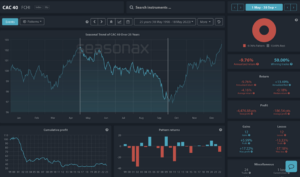Today marks another monthly expiration, and I reiterate my usual reminder for traders to keep a close eye on high volumes and open interests in options on key stocks and ETFs (this week, watch SPY and QQQ as always, along with AAPL and TSLA ahead of their upcoming splits). But there is a key market indicator flashing a warning signal.
The Advance/Decline line is failing to confirm the major indices’ new highs. The difference between advances and declines is referred to as “breadth”. A commonly held market narrative is that new highs should be confirmed by a broad based advance, where most stocks are rising to confirm the indices’ upward trend. When more stocks are advancing than declining, it shows that a wide range of companies are participating in the market’s move. When indices rise on shrinking breadth, it indicates that the market’s leadership is narrowing.
Consider the following graphs. The first is the year-to-date performance of the S&P 500 Index (SPX, white line) and NASDAQ 100 Index (NDX, yellow) compared to the cumulative advance/decline lines on the NYSE (red) and NASDAQ (blue) exchanges. We can see that the paths of the advance/decline lines largely follow those of the major indices:

Source: Bloomberg
But I highlight the most recent behavior in the second graph. We can see a notable decline in the breadth measures over the past few sessions:


Source: Bloomberg
Is this a meaningful trading signal? Not necessarily. Breadth can diverge from the broader indices for some time before a trend changes. Also, short-term lagging breadth measures can simply recover before any damage occurs to a longer term trend. But a divergence of this type highlights potential cracks underlying a market’s solid-looking foundation.
We have discussed that the major indices, which are weighted by market capitalization, are increasingly dominated by a small group of top performing mega-capitalized stocks. The top five companies in the NASDAQ 100 (NDX) index make up about half of the index’ weight, and those companies make up about a quarter of the weight of the S&P 500 (SPX). If those companies advance strongly enough, they can drag the indices along with them. Yet that exposes a vulnerability – what happens if sentiment turns negative? If those stocks fall out of favor, they expose the indices to a disproportionate decline. That is the crux of the market’s focus on breadth. When gains are well distributed throughout a broad range of solidly performing stocks, markets can more easily weather sentiment changes in a group of market leading stocks.
This combination of narrow leadership and shrinking breadth raises the risk level in equity markets. The rewards of investing in the leading stocks have been unmistakable. Yet their high valuation and market concentration mean that the market’s foundation is increasingly reliant on a narrow group of market leaders. This increases the risk to indices as a whole in a subtle manner. As always, investors need to assess whether they are properly exposed to that level of concentration.
Disclosure: Interactive Brokers
The analysis in this material is provided for information only and is not and should not be construed as an offer to sell or the solicitation of an offer to buy any security. To the extent that this material discusses general market activity, industry or sector trends or other broad-based economic or political conditions, it should not be construed as research or investment advice. To the extent that it includes references to specific securities, commodities, currencies, or other instruments, those references do not constitute a recommendation by IBKR to buy, sell or hold such investments. This material does not and is not intended to take into account the particular financial conditions, investment objectives or requirements of individual customers. Before acting on this material, you should consider whether it is suitable for your particular circumstances and, as necessary, seek professional advice.
The views and opinions expressed herein are those of the author and do not necessarily reflect the views of Interactive Brokers, its affiliates, or its employees.
Disclosure: Futures Trading
Futures are not suitable for all investors. The amount you may lose may be greater than your initial investment. Before trading futures, please read the CFTC Risk Disclosure. A copy and additional information are available at ibkr.com.






























